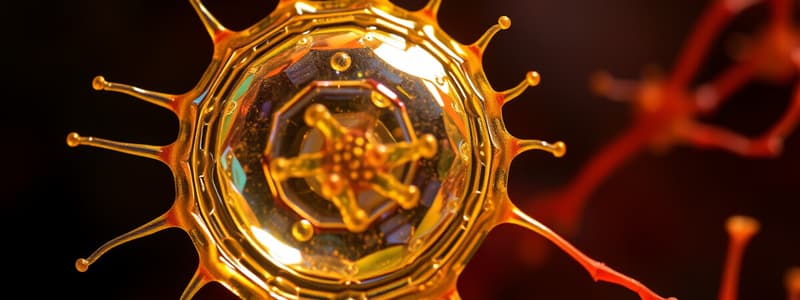Podcast
Questions and Answers
What is the main role of the Golgi apparatus in a cell?
What is the main role of the Golgi apparatus in a cell?
- Initiating cellular respiration
- Modifying, sorting, and packaging proteins (correct)
- Protein synthesis
- Transporting nutrients across the cell membrane
Which organelle is known as the 'suicide bag' of the cell?
Which organelle is known as the 'suicide bag' of the cell?
- Lysosome (correct)
- Endoplasmic reticulum
- Mitochondria
- Ribosome
What is the primary function of mitochondria in eukaryotic cells?
What is the primary function of mitochondria in eukaryotic cells?
- Energy production in the form of ATP (correct)
- Storage of genetic material
- Transport of substances in and out of the cell
- Protein synthesis
What distinguishes eukaryotic cells from prokaryotic cells?
What distinguishes eukaryotic cells from prokaryotic cells?
In which part of the cell does protein synthesis occur?
In which part of the cell does protein synthesis occur?
What is the main structural component of the cytoskeleton?
What is the main structural component of the cytoskeleton?
What type of cellular structure is the endoplasmic reticulum primarily involved in?
What type of cellular structure is the endoplasmic reticulum primarily involved in?
How do saturated hydrocarbons differ from unsaturated hydrocarbons?
How do saturated hydrocarbons differ from unsaturated hydrocarbons?
Which function of the cell membrane is crucial for maintaining cellular homeostasis?
Which function of the cell membrane is crucial for maintaining cellular homeostasis?
What unique structure is seen during cell division within the nucleus?
What unique structure is seen during cell division within the nucleus?
Which characteristic of life refers to the ability of an organism to maintain a stable internal environment regardless of external changes?
Which characteristic of life refers to the ability of an organism to maintain a stable internal environment regardless of external changes?
What does the modern cell theory state about the origin of cells?
What does the modern cell theory state about the origin of cells?
Which of the following best describes the metabolic process of respiration?
Which of the following best describes the metabolic process of respiration?
What is the primary function of organelles within a cell?
What is the primary function of organelles within a cell?
What is the process called when living organisms respond to environmental stimuli?
What is the process called when living organisms respond to environmental stimuli?
Which type of reproduction involves the combination of genetic material from two parents?
Which type of reproduction involves the combination of genetic material from two parents?
What is the sum of all chemical reactions that occur in an organism known as?
What is the sum of all chemical reactions that occur in an organism known as?
What form of energy transformation occurs within cells during metabolism?
What form of energy transformation occurs within cells during metabolism?
Which structural component is NOT typical of prokaryotic cells?
Which structural component is NOT typical of prokaryotic cells?
Which characteristic of life allows organisms to change over generations to better suit their environments?
Which characteristic of life allows organisms to change over generations to better suit their environments?
Flashcards are hidden until you start studying
Study Notes
Characteristics of Life
- Living organisms exhibit organization, structured from cells to complex entities.
- Metabolism refers to chemical processes converting energy and materials for growth.
- Homeostasis maintains stable internal environments despite external changes.
- Growth and development are guided by genetic instructions encoded in DNA.
- Reproduction allows organisms to pass on genetic information to offspring.
- Organisms respond to environmental stimuli.
- Evolution enables living things to adapt to their changing environments.
Modern Cell Theory
- All living things are composed of cells.
- Cells are the basic unit of structure and function in life.
- New cells arise from pre-existing cells.
- Cells share a similar chemical composition.
- Cells consist of organelles, which are primarily made up of proteins.
- Hereditary information is transmitted from cell to cell during division.
- Metabolic processes, including energy transformations, occur within cells.
Functional Levels of Life
- Homeostasis refers to an organism's ability to maintain internal balance.
- Reproduction can be sexual or asexual; examples include sponges and bacteria.
- Adaptations enable organisms to adjust to their environments.
Basic Cell Structure
- Plant cells typically have a rigid square shape, while animal cells have varied, irregular shapes.
- Eukaryotic cells contain a cell membrane, nucleus, and cytoplasm.
Cell Organelles
- Eukaryotic cells differ distinctly from prokaryotic cells due to the presence of a nucleus.
- The cell membrane regulates materials' entry and exit, exhibiting selective permeability.
- The cytoplasm contains organelles suspended in a thick aqueous solution and facilitates nutrient distribution through cytoplasmic streaming.
- The nucleus is the control center containing organized DNA (chromosomes) and is enclosed by the nuclear membrane.
Membrane-Bound Organelles
- Key organelles include the endoplasmic reticulum (rough and smooth types), Golgi apparatus, lysosomes, mitochondria, and chloroplasts.
- Rough ER is associated with ribosome activity and protein production; smooth ER lacks ribosomes and is involved in lipid production.
- The Golgi apparatus processes and packages proteins received from the ER.
- Lysosomes act as waste disposal, containing enzymes that degrade damaged components.
- Mitochondria, known as the powerhouse of the cell, are sites for cellular respiration and energy (ATP) production.
Cytoskeleton
- The cytoskeleton provides structural support and shape to the cell.
Chemistry of Carbon
- Carbon is located in the second row of the periodic table with an atomic number of 6.
- Tetravalent nature allows carbon to form four covalent bonds.
- Hydrocarbons can be classified as saturated (alkanes, cycloalkanes) and unsaturated (alkenes, alkynes, benzene).
- Functional groups in organic molecules provide structural foundations for various compounds.
Studying That Suits You
Use AI to generate personalized quizzes and flashcards to suit your learning preferences.




